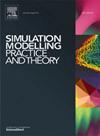基于核力理论的改进社会力模型,模拟不同能见度条件下的建筑物疏散
IF 3.5
2区 计算机科学
Q2 COMPUTER SCIENCE, INTERDISCIPLINARY APPLICATIONS
引用次数: 0
摘要
准确模拟行人在不同能见度条件下的行为对于减少火灾紧急疏散过程中的人员伤亡至关重要。目前的研究通常采用社会力模型来模拟行人在特定能见度条件下的相互作用力。然而,这些研究往往不能充分捕捉到能见度变化对行人相互作用力的动态影响。基于核力理论,建立改进的社会力模型(NSFM),纳入环境能见度参数,建立相应的行人运动规则。此外,我们还研究了行人和墙壁之间的相互作用,以确定最佳参数。然后,通过比较之前基于能见度的疏散实验和其他模型在特定能见度条件下的模拟结果,验证了该模型的准确性。此外,我们还在不同的能见度条件下进行了模拟,结果表明,能见度降低会加剧随墙行为和羊群效应,导致更多的绕行行为、更慢的移动速度和更长的疏散时间。随着能见度的增加,对疏散的影响逐渐减弱。最后,我们研究了出口数量和位置的影响,发现出口数量的增加大大缩短了疏散时间,而出口位置的变化会显著影响疏散效率。数值模拟结果表明,NSFM在模拟不同能见度条件下行人疏散行为和过程方面具有显著的潜力,为未来设计更有效的疏散策略提供了科学依据。本文章由计算机程序翻译,如有差异,请以英文原文为准。
An improved social force model based on nucleus force theory to simulate building evacuation in different visibility conditions
Accurately simulating pedestrian behaviour under different visibility conditions is crucial for reducing casualties during emergency fire evacuations. Current research employing social force models typically simulates pedestrian behaviour based on interaction forces under specific visibility conditions. However, these studies often inadequately capture the dynamic effects of visibility changes on pedestrian interaction forces. Based on the nucleus force theory, this study developed an improved social force model (NSFM), incorporating environmental visibility parameters, establishing corresponding pedestrian movement rules. Additionally, we investigated the interaction between pedestrians and walls to determine the optimal parameters. The model’s accuracy was then validated by comparing its simulations under specific visibility conditions from previous visibility-based evacuation experiments and results from other models. Furthermore, we conducted simulations under different visibility conditions, the results show that reduced visibility intensifies wall-following behaviour and herd effects, leading to more detour behaviour, slower movement velocity, and longer evacuation times. As visibility increases, the impact on evacuation gradually diminishes. Finally, we investigated the impact of the number and location of exits and discovered that increasing the number substantially reduces evacuation time, while changes in exit locations can notably affect evacuation efficiency. The numerical simulation results demonstrate that the NSFM has significant potential for simulating pedestrian evacuation behaviour and processes under different visibility conditions, providing a scientific basis for designing more effective evacuation strategies in the future.
求助全文
通过发布文献求助,成功后即可免费获取论文全文。
去求助
来源期刊

Simulation Modelling Practice and Theory
工程技术-计算机:跨学科应用
CiteScore
9.80
自引率
4.80%
发文量
142
审稿时长
21 days
期刊介绍:
The journal Simulation Modelling Practice and Theory provides a forum for original, high-quality papers dealing with any aspect of systems simulation and modelling.
The journal aims at being a reference and a powerful tool to all those professionally active and/or interested in the methods and applications of simulation. Submitted papers will be peer reviewed and must significantly contribute to modelling and simulation in general or use modelling and simulation in application areas.
Paper submission is solicited on:
• theoretical aspects of modelling and simulation including formal modelling, model-checking, random number generators, sensitivity analysis, variance reduction techniques, experimental design, meta-modelling, methods and algorithms for validation and verification, selection and comparison procedures etc.;
• methodology and application of modelling and simulation in any area, including computer systems, networks, real-time and embedded systems, mobile and intelligent agents, manufacturing and transportation systems, management, engineering, biomedical engineering, economics, ecology and environment, education, transaction handling, etc.;
• simulation languages and environments including those, specific to distributed computing, grid computing, high performance computers or computer networks, etc.;
• distributed and real-time simulation, simulation interoperability;
• tools for high performance computing simulation, including dedicated architectures and parallel computing.
 求助内容:
求助内容: 应助结果提醒方式:
应助结果提醒方式:


